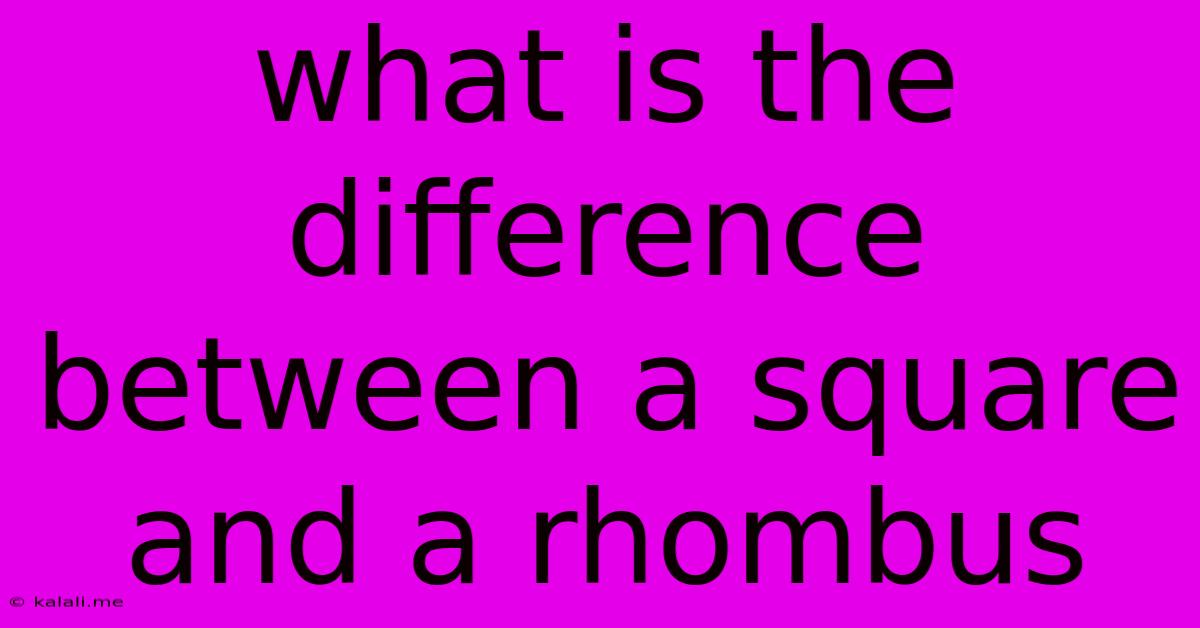What Is The Difference Between A Square And A Rhombus
Kalali
Jun 14, 2025 · 3 min read

Table of Contents
What's the Difference Between a Square and a Rhombus? A Geometry Deep Dive
Squares and rhombuses are both quadrilaterals – four-sided polygons – but they possess distinct characteristics that set them apart. While a rhombus shares some features with a square, understanding their differences is crucial for grasping fundamental geometric concepts. This article will explore the key distinctions between these two shapes, clarifying their properties and helping you easily identify each.
Key Differences: A Simple Breakdown
The core difference boils down to the angles and side lengths. A square is a special type of rhombus with additional constraints on its angles. Let's break it down:
-
Squares: Have four equal sides and four equal angles (90 degrees each). They are both equilateral (equal sides) and equiangular (equal angles). Think of a perfect, symmetrical tile.
-
Rhombuses: Have four equal sides, but their angles are not necessarily equal. They can be “squashed” or “stretched,” resulting in angles that vary. Only in the special case of a rhombus with 90-degree angles do we have a square.
Visualizing the Differences
Imagine trying to draw both shapes. Drawing a square is straightforward – all sides and angles are the same. Drawing a rhombus, however, offers more flexibility. You can start with four equal length sides but adjust the angles, creating a variety of shapes while still maintaining the equal side length property. A rhombus can be tilted or slanted; a square cannot.
Properties of Squares and Rhombuses: A Detailed Comparison
| Feature | Square | Rhombus |
|---|---|---|
| Sides | Four equal sides | Four equal sides |
| Angles | Four 90-degree angles | Opposite angles are equal, but not necessarily 90 degrees |
| Diagonals | Equal diagonals that bisect each other at 90 degrees | Diagonals bisect each other, but are not necessarily equal and do not necessarily intersect at 90 degrees |
| Symmetry | Rotational symmetry of order 4, multiple lines of reflectional symmetry | Rotational symmetry of order 2, one line of reflectional symmetry |
| Area Calculation | Side * Side (s²) | Base * Height |
Beyond the Basics: Understanding the Hierarchy
It's helpful to visualize the relationship between squares and rhombuses within a broader geometric hierarchy. A square is a special case of a rhombus, meaning all squares are rhombuses, but not all rhombuses are squares. This is because squares fulfill all the requirements of a rhombus plus the additional requirement of having right angles. Similarly, both squares and rhombuses are types of parallelograms (opposite sides are parallel and equal).
Real-world Applications
Understanding these geometric shapes has practical applications. Squares are prevalent in architecture and design, while rhombuses can be found in various natural formations and crystal structures. Recognizing the distinctions helps in understanding the properties and applications of each shape in different contexts.
By now, you should have a firm grasp of the differences between squares and rhombuses. Remember that a square is a special type of rhombus with the added condition of having four right angles. Mastering these concepts will enhance your understanding of geometry and its applications.
Latest Posts
Latest Posts
-
What Day Of The Week Is November 17th
Jun 15, 2025
-
Largest Freshwater Lake In World By Volume
Jun 15, 2025
-
A Person Who Believes Everything Easily
Jun 15, 2025
-
Which Of The Following Defines The First Law Of Thermodynamics
Jun 15, 2025
-
25 Of What Number Is 6
Jun 15, 2025
Related Post
Thank you for visiting our website which covers about What Is The Difference Between A Square And A Rhombus . We hope the information provided has been useful to you. Feel free to contact us if you have any questions or need further assistance. See you next time and don't miss to bookmark.